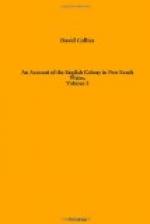A canoe was never met with, and concurring circumstances showed that this convenience was unknown here; nor was any tree ever observed to be barked in the manner requisite for this purpose; though birds bred upon little islands to which access might be had in the smallest canoe. Those made of solid timber seemed to be wholly out of the question. The roughness of the notches left by the stone hatchet upon the bark of the trees bore no very favourable testimony to its excellence. They were rather the marks of a rough than of a sharp-edged tool, and seemed more beaten than cut, which was not the case with the marks left by the mo-go, or stone hatchet, of New South Wales.
Hence, from the little that has been seen of the condition of our own species in this place, it appears to be much inferior in some essential points of convenience to that of the despised inhabitants of the continent. How miserable a being would the latter be, his canoe taken from him, his stone hatchet blunted, his hut pervious to the smallest shower of rain, and few or no excavations in the rocks to fly to! But happiness, like every thing else, exists only by comparison with the stage above and the stage below our own. The circumstances which occasioned this difference between the people of two countries so near to each other, and so much alike in their natural productions, must remain hidden from our observation, until perhaps some permanent European settlement shall be made in Van Diemen’s land.
The range of the thermometer, taken in various parts of the port, was at night from 49 degrees to 52 degrees, and at noon from 58 degrees to 64 degrees.
On the 20th of November they left Port Dalrymple with a light breeze at NE and proceeded very slowly to the westward. At daylight the following morning, the wind shifted to the W by N which drove them back to Furneaux’s islands, where, the gale continuing at west, they were kept until the 3rd of December, when they were enabled to proceed to the westward. The land here trended to the WNW as far as was visible through the haze, which allowed them only to distinguish that it was high and uneven. At noon the latitude was 40 degrees 58 minutes, and the longitude 146 degrees 44 minutes. Their progress was slow, and unavoidably at too great a distance from the shore to form any just idea of the country; but what was seen of it appeared high and mountainous, the mountains forming into hummocks and low peaks, to which a few large shapeless knobs added a great singularity of appearance. On the haze clearing away, and the shore being distinctly seen, it appeared rocky, but wooded nearly down to the water’s edge. Here and there were seen spaces of open ground, some of which sloped toward the sea, and had a few large trees growing irregularly upon them. A remarkable peaked mountain, some few miles inland, might have been thought, from its shape and height, to have been once a volcano. A very singular lump of high level, or table land, lay at a few miles to the westward in the coast line; and at some distance beyond it, a point appeared with three knobs of land lying off it, resembling islands. This land was named Table Cape.




